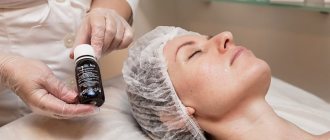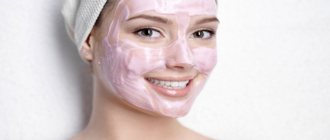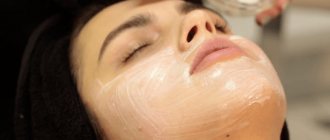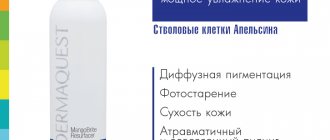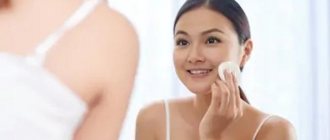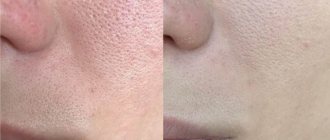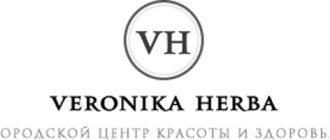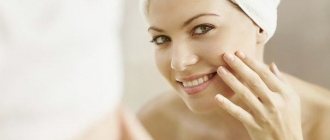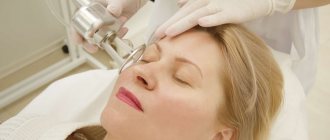From this article you will learn:
- Composition of keratoregulating peeling
- Indications for keratoregulating peeling
- Stages of procedure in a beauty salon
- Features of skin care after the keratoregulating peeling procedure
- Contraindications and possible complications after the procedure
- Is it possible to use drugs for keratoregulating peeling at home?
- Frequently asked questions about the keratoregulating peeling procedure
Keratoregulating peeling helps to smooth the surface of the epidermis, which, due to age-related changes and other external and internal factors, becomes heterogeneous and rough. Beneficial substances can no longer penetrate through such tissues, and therefore the skin loses its freshness and healthy appearance.
Keratoregulating peeling helps to cope with insufficiency of cellular respiration. It not only smoothes the surface of the epidermis, but also restores the tissue structure. The skin becomes tender and soft again, peeling and unhealthy color are eliminated. Such a beneficial effect of keratoregulating peeling is achieved both due to active acids and due to the component included in the composition, which ensures the delivery of beneficial ingredients even to the deep layers. Let's learn more about this wonderful procedure, the results of which are in many ways superior to the effect of conventional peeling.
Composition of keratoregulating peeling
Keratoregulating peeling is a cosmetic procedure that can quickly improve the condition of the skin. It accelerates the detachment of the stratum corneum. However, this is not its only function.
Keratoregulating peeling is also capable of:
- Cure acne, prevent the occurrence of this disease.
- Add freshness and healthy glow to your skin.
- Rid the skin of acne and open comedones (blackheads).
- Eliminate folliculitis.
- Establish blood circulation in tissues.
- Normalize the deposition of keratin in the stratum corneum of the skin, reduce the intensity of sebum secretion.
- Cleanse the skin.
- Improve skin texture, even out its tone.
The peeling contains many active components. They are responsible for the beneficial properties of this procedure.
- Glycolic acid. Promotes the rejection of dead skin cells, regulates the formation of horny substance from the epidermis. Glycolic acid performs a number of functions, stimulating:
- release of oxidation products accumulated in skin cells;
- enhanced synthesis of elastin and collagen fibers;
- cessation of inflammatory processes.
Recommended articles on the topic:
- Ultrasonic facial peeling is a pleasant and beneficial procedure for your skin
- Redermalization of the skin: all the pros and cons
- Almond peeling for the face: features of the procedure
Glycolic acid also acts as a conductor. It helps other active components included in the peeling penetrate into the deep layers of the skin.
- Soy phytoestrogens. Genistein is a plant substance obtained from soybeans. It is a natural antioxidant:
- normalizes sebum secretion;
- regulates skin renewal;
- helps strengthen the walls of blood vessels;
- accelerates the process of tissue regeneration.
Genistein has a beneficial effect on problem skin due to its ability to kill germs.
- Salicylic acid is a substance that eliminates inflammatory processes.
- Silk proteins have a bactericidal effect. They stop the further development of the infection and stop the inflammatory process.
- Retinyl palmitate is a component that prevents new age spots from appearing. The substance also helps improve immunity and reduces sebum secretion.
- Zinc is a chemical element that increases skin tone.
- Natural hormones of plant origin (diosgenin glycoside). Diosgenin glycoside is a plant hormone that is part of the keratoregulating peeling. Its main functions are:
- normalization of the balance of hormones and metabolic processes in skin cells;
- stimulating restoration processes;
- accelerating skin tightening;
- improving blood circulation.
- Vitamin C acts as an antioxidant. It also helps eliminate inflammatory processes, stimulates the synthesis of the “hormone of youth” (collagen) and lightens age spots.
Varieties
Keratoregulating
Release form: bottle with dispenser 30 ml. Price: 10,300 rub.
The drug is recommended for oily, problematic skin that is prone to acne and inflammation. Contains glycolic and salicylic acid, genistein, vitamin C, zinc, silk extracts.
Impact:
- normalization of the sebaceous glands;
- narrowing of pores;
- whitening pigmentation;
- smoothing the relief;
- stabilization of intracellular processes.
Renewlift
Release form: bottle with dispenser 30 ml. Price: 10,440 rub.
The exfoliant contains: partially neutralized glycolic acid 68%, diosgenin, Asian centella extract. Indicated for mature skin over 40 years old.
Buyanov Sergey Yurievich (Expert Doctor):
Centella asiatica is otherwise called tiger grass. In the composition of cosmetics it is noted as madecassoside, by the name of the main component. A herbal product has long been used in Eastern medicine for skin damage because it stimulates the growth of collagen fibers.
Provides a lifting effect, restores the cellular matrix, normalizes hydrobalance, increases skin density, and synthesizes necessary hormones.
Reprogramming
Release form: bottle with dispenser 30 ml. Price: 10,100 rub.
The composition is represented by 4% salicylic and 70% glycolic acids, genistein, retinol, tocopherol, vitamin C. It is aimed at intensive correction and prevention of age-related changes, therefore it is used after 25 years.
Restores the dermal matrix, compacts the collagen framework and activates the protective barrier. The product removes toxins and metabolic products, normalizes hydrobalance and has antioxidant properties.
Indications for keratoregulating peeling
The unique component composition of keratoregulating peeling allows it to eliminate many cosmetic problems:
- Acne, which is accompanied by minor inflammation. White and black pimples, blockage of pores with sebaceous plugs.
- Seborrheic dermatitis of the skin and other skin diseases accompanied by peeling (as prescribed by the doctor).
- Inflammatory processes, as well as suppuration of the hair follicles of the facial area (characteristic of the outer layer of oily skin, which is prone to the appearance of enlarged pores and various rashes).
- Thickened stratum corneum of the skin due to a slowdown in metabolism due to age-related changes.
Keratoregulating peeling is suitable for preventing the formation of comedones. This cosmetic procedure is often used for hygienic facial cleansing for those with problem skin.
Peeling with a keratoregulating effect helps solve many skin problems. In addition, it has a number of additional effects: lightens the skin, eliminates scars, and removes pigmentation. Like all skin cleansing procedures, it has a rejuvenating effect, smoothing out fine expression wrinkles. Characterized by a cumulative effect. The more often you do keratoregulating peeling, the better the result.
The best thing is that the effect of the cosmetic procedure is visible immediately. He will delight you for six months.
It is no secret that the skin, and especially the skin of exposed surfaces (face, neck, décolleté, hands) plays a significant role in shaping the aesthetic appeal of a person’s image. Unfortunately, like other organs, the skin undergoes age-related changes, which can create certain problems and complexes in people; Moreover, the share of the subjective factor in this issue seems to be very high. Involutional changes in the skin are caused by a decrease in the mitotic activity of epidermal and dermal cells, thinning of the Malpighian layer, hyperkeratosis, smoothing of the dermoepidermal border, a decrease in the number of full-fledged type I collagen fibers, elastic fibers, and glycosaminoglycans. Skin aging is characterized by changes in its density, elasticity, ptosis and the formation of wrinkles; in this case, the skin has a covering function, but does not support the rest of the facial tissues. This circumstance seems important from the standpoint of the correct choice of methods for correcting age-related changes in the face, since in addition to the skin, the involution process involves fatty, muscle and bone tissue, and therefore not all costs of age can be corrected by influencing only the skin.
Often, professional and/or personal motives to smooth out the influence of time lead a person to specialists in the field of plastic surgery and aesthetic cosmetology. Currently, to solve this problem, peeling has become widespread as an effective procedure that can eliminate a number of skin defects, as well as promote its “rejuvenation.”
Peeling
(from the English to peel, to peel off - peel off, exfoliate, exfoliate)
is the controlled removal of a certain number of layers of the epidermis and dermis along with existing defects to initiate the restoration of all destroyed layers. Thus, the physiological basis of peeling is stimulation of regeneration.
The doctrine of regeneration is one of the key branches of biology and medicine. Regeneration or revival is the property of organisms to re-form their organs and tissues that have been lost as a result of various reasons. Since the end of the 19th century. There is a division of regeneration into physiological and reparative, however, at present the border between these two types does not seem sharp. Reparative regeneration is based on physiological, the mechanisms for implementing the process are largely identical, and the differences are predominantly quantitative.
A cosmetologist, inflicting damage to the patient’s skin during salon peeling, stimulates reparative processes in it, the degree of manifestation of which depends on the nature and area of the injury. Thus, we can say that the basis of the corrective and “rejuvenating” effects of peeling is reparative (regenerative) morphogenesis.
The healing process can be considered as a complex sequence of interactions between cells, mediators, and components of the intercellular matrix, in the implementation of which a significant role (integration and operational communication) belongs to signaling protein molecules—cytokines.
Indications for peeling include seborrhea, acne and post-acne skin changes, scars, hyperpigmentation, actinic dermatitis, keratosis, hyperkeratosis, age-related skin changes (wrinkles, small folds, decreased turgor), etc. From the perspective of the doctrine of regeneration in elderly and senile people , which is characterized by thinning and atrophy of the skin, it does not seem advisable to prescribe peeling.
Based on the method of exposure, the following main types of peeling are distinguished:
- Mechanical
- superficial, medium (microdermabrasion) and deep (standard dermabrasion). This group includes gommage (peeling without abrasive particles by applying a special mixture to the skin, gluing it to the surface layer of the epidermis, followed by “rolling off” dead horny scales from the facial skin - similar to the action of a pencil eraser), peeling scrub (using abrasive particles) , brossage (hardware or brush peeling). - Chemical
- superficial (fruit acids), middle (salicylic and trichloroacetic acids), deep (phenol). - Physical
- superficial (ultrasound, erbium laser), medium (erbium laser with a penetration depth of 30 microns), deep (carbon dioxide laser with a penetration depth of 80-150 microns).
It should be noted that any type of deep peeling is an aggressive procedure for the skin.
The earliest mentions of manipulations similar to chemical peeling are found in ancient Egyptian papyri dating back to 1.5 thousand years BC. e. Since time immemorial, women have practiced exfoliating the top layers of skin to get rid of aesthetic imperfections on the face. Thus, Turkish women singed their skin with fire, Indian women used urine, Egyptian women used milk sourdough, ancient Roman courtesans, and later French women used grape must.
In the second half of the 19th century. German dermatologist Unna developed a dermatological chemical peeling method using resorcinol, salicylic and trichloroacetic acids for the treatment of certain skin diseases.
At the beginning of the 20th century. French surgeon La Gasse proposed phenol peeling, which was first used to correct gunpowder burns during the First World War. The surgeon's daughter took her father's secret recipes to California, where she introduced peeling into fashion in beauty salons in California and Florida.
In 1903, MasKee's work on the use of phenol solution for peeling was published, and in 1905, Kromayer unveiled a mechanical method for treating acne scars, keratosis and hyperpigmentation by treating the skin with rotating cutters, i.e., the dermabrasion method.
Van Scott's 1974 discovery of the properties of alpha-hydroxy acids and Kligman's research on the use of vitamin A as a treatment for photoinduced skin aging stimulated the widespread use of chemical peeling methods. Chemical peeling can be one-step and requires repetition, it can be carried out using various forms of cosmetics (cream, gel, solution, mask), and can also differ in the method of achieving the goal (peel exfoliant and peeling serum).
Peeling exfoliant
(using trichloroacetic, salicylic acids) promotes the development of a process traditionally called reparative regeneration. Moreover, depending on the depth of skin damage, a different range of structures is involved in its “rebirth”. Thus, when the surface layers of the epidermis are destroyed, restoration is carried out mainly due to the cambial elements of the skin epithelium located in its basal layer, i.e., on the basis of physiological regeneration of the epidermis, mainly by increasing its rate. At the same time, under the influence of cytokines synthesized by keratinocytes, the dermal elements are also activated, and the synthesis of collagen and glycosaminoglycans is enhanced.
With deep damage to the epidermis, and in some procedures to the dermis (phenol peeling), the main source of epithelial cells becomes the cambial elements of the skin appendages - hair follicles and glands, and processes similar to the healing of skin wounds develop in the dermis. The fibrosis of the dermis that forms during deep peeling as a result of the regenerative process, being essentially a pathological phenomenon, nevertheless contributes to the lifting effect desired and expected from the peeling. No other peeling gives such an effective and lasting result in the fight against deep expression wrinkles; Moreover, the achieved effect can last for 5-10 years after the procedure. Phenol peeling is called the “gold standard” of chemical peels. It is given to the patient once in a lifetime. Depending on how accurately the regenerative capabilities of the patient’s skin were assessed and how competently the procedure itself was carried out, phenol peeling either transforms the face, erasing wrinkles and other defects, or creates serious and long-term aesthetic problems for the patient.
The peeling serum causes loosening and exfoliation of the stratum corneum, but the main effect is achieved by weakening the barrier properties of the epidermis and facilitating the penetration into its deep layers of components that affect physiological regeneration. To do this, use a combination of alpha-hydroxy acids (glycolic, fruit, etc.), beta-hydroxy acids (salicylic acid, which has a keratolytic effect), retinol (vitamin A) and ascorbic acid (vitamin C), i.e. combined peeling ABR family (alpha-beta-retinol). The author of the monograph on the problem of peeling (2008) is N.A. Polonskaya believes that the further development of this branch of dermatocosmetology should not follow the path of increasingly severe and deep trauma to the skin, but in the direction of using the skin’s own resources and the body as a whole, using the most physiological methods of influence, if possible without depleting the reparative potential. In this regard, it is worth mentioning that many substances have the property of modulating, and in the light of the problem under discussion, stimulating the physiological regeneration of keratinocytes, and among retinoids, not only retinol, but also retinoic acids. For 13-cis-retinoic acid (INN - isotretinoin), this property has been proven experimentally using morphometric and quantitative immunomorphological studies using markers of DNA synthesis and proliferation - PCNA and Ki-67.
At the end of the 80s. XX century American dermatologist Obagi has developed a “Comprehensive Care Program”, which includes preparing the skin for a chemical peeling procedure and rehabilitation methods. According to his concept, the peeling procedure should include 3 fundamental phases:
- The preparatory stage (pre-peeling)
is aimed at leveling the epidermis and thinning its stratum corneum in order to more evenly penetrate acids and minimize the risk of post-inflammatory hyperpigmentation; at the same time, the reactive properties of the skin and its tolerance to the substances used in the peeling program are checked; - Peeling
; - Recovery period (post-peeling)
- involves a gentle regime (lack of physical activity, minimum facial expressions, avoidance of excess sweating, sleeping on your back, washing with non-hot water), using a moisturizer and sunscreen, spraying mineral water on the skin surface, applying a rich cream at night, when the skin is restored; Of the retinoids, retinol is most often used, applying it in the evening.
Patient management tactics are determined by the characteristics of the morphogenesis of skin structures at a specific stage of the process. Thus, in the acute phase of inflammation (immediately after the peeling procedure), the use of external agents that prevent transepidermal water loss is justified; later efforts should be aimed at eliminating erythema, swelling, preventing the contamination of the wound surface with pathogenic microflora and accelerating wound healing. These circumstances contribute to an intensive search for new means to obtain optimal results.
Contraindications to peeling are many skin diseases (eczema, psoriasis, allergic dermatoses), herpes infection, intolerance to photoprotective agents, pregnancy, the presence of multiple pigmented nevi on the face, hypertension, epilepsy, cancer, a special psychological type of the patient and others.
IN AND. Samartsev and T.R. Minaev note that most contraindications to peeling are relative. When deciding whether to prescribe phenol peeling, special caution should be exercised in relation to patients suffering from diseases of the cardiovascular system, kidneys and liver, since phenol has a toxic effect on these organs as a result of resorption. When performing phenol peeling, it is necessary to have a catheterized vein and the presence of equipment for cardiac monitoring and resuscitation in the operating room.
It should be emphasized that when deciding whether to prescribe peeling, special attention should be paid to the condition of the skin appendages (hair, sebaceous and sweat glands), since it is through them that the skin is largely restored after damage.
Ideas about the permissible depth of peeling vary in the literature. Numerous classifications allow for the possibility of skin damage during peeling, mainly within the epidermis, sometimes the papillary layer of the dermis, and in exceptional cases (with deep phenol peeling) - partially, the reticular layer of the dermis.
Below is a comparative description of the classifications of peelings, according to foreign and domestic publications, presented in the reports of the Scientific and Practical Conference “The Use of Chemical Peels in Dermatocosmetology”:
- superficial peeling
- performed with alpha-hydroxy acids (AHA), retinoids, alpha and beta complexes, while abroad up to the basement membrane, in Russia - within the stratum corneum; - median
- performed with trichloroacetic acid, Jessner's solution (a mixture of resorcinol, trichloroacetic and lactic acids), salicylic acid, abroad within the papillary layer of the dermis, in Russia - within the epidermis; - deep
- performed with phenol, abroad - to the reticular layer of the dermis, in Russia - to the papillary layer.
It should be borne in mind that when carrying out deep peeling, affecting the dermis, you have to sacrifice the epidermis. Cases where acid (all of the compounds presented above are acids) reaches the hypodermis are regarded as an emergency, since such a situation threatens the formation of rough scars.
ON THE. Polonskaya suggests classifying peelings based on the degree of skin damage:
- 1st degree
- within the stratum corneum; - 2nd degree
- within the epidermis without damage to the basal layer; - 3rd degree
- with partial damage to the basal layer; - 4th degree
- with complete destruction of the basal layer.
The degree of damage to skin structures during salon peeling determines the characteristics and duration of the recovery period.
Currently, there is a noticeable advancement of various aggressive techniques, which dictates the need for constant discussion of the feasibility of certain procedures, including on the pages of professional publications. When deciding on the use of a specific technique, it is necessary, first of all, to be guided by the principle “do no harm.” At the same time, both the patient and the cosmetologist are interested in obtaining a positive result. Particular skill lies in the ability to determine the degree of activity of the influence, which allows you to achieve the desired without significant side effects.
The most common currently are peels performed with AHA (mainly glycolic) and retinoic peels. Without touching on the details of the procedures used, we will name the main mechanisms of dermatotropic effects that develop during their implementation and lead to the expected result.
Glycolic acid has a high degree of penetration, its action is based on the destruction of sulfate bonds between corneocytes, disruption of cell adhesion and acceleration of exfoliation, as well as an increase in the number of mitoses in the basal layer of the epidermis. It stimulates collagen synthesis, has an antioxidant, moisturizing effect, reduces the number of melanocytes, and reduces melanin synthesis.
Retinoic peeling
(Yellow Peel) in beauty salons is carried out in the form of applying a mask with 5% retinoic acid. Peeling with retinoids meant a completely new approach to solving the problem of age-related skin changes. These compounds contribute to an increase in the level of mitotic activity of keratinocytes, normalize their differentiation and keratinization, activate the synthesis of the main structures of the dermal matrix (collagen, elastin, glycosaminoglycans), improve re-epithelialization, have a depigmenting and exfoliating effect, have a sebostatic and comedolytic effect, and improve skin texture.
Retinoids for peeling seem to be more promising in their potential than AHAs. By binding to specific cell receptors, they have a direct effect on the epidermis and dermis, while ANAs do not have a direct effect on cells; The clinical effects of ANAs result from indirect activation of keratinocytes in response to increased exfoliation, and stimulation of fibroblasts represents a response to inflammation. At the same time, the author (O.V. Zabnenkova) provides a comparative description of the clinical effectiveness of ANA and retinoids - tretinoin, isotretinoin (which is assessed as equal to tretinoin in therapeutic terms, but with a less irritating effect) and retinol palmitate, and notes that, despite the obvious advantage of retinoids, ANAs continue to occupy a leading position in superficial chemical peeling due to good clinical effect and the absence of systemic complications. The question of what to give preference to in specific cases must be decided individually. Thus, the clinical effects of the use of retinoids are delayed compared to ANA, but persist for 4 months after cessation of use, while with peelings using ANA, the clinical effect is noticeable after each procedure, but pathological keratinization reappears after 3 weeks. In case of photoaging, the use of retinoids, especially tretinoin (all-trans retinoic acid), is pathogenetically more justified, which has been proven at the clinical, histological and molecular levels. The combined use of superficial chemical peeling with glycolic acid with deep stimulation of the dermis by exposing the skin to a cream containing a high concentration (5%) of retinoic acid allows one to achieve optimal results in the correction of cosmetic defects caused by age-related changes.
The main directions of use of retinoids in cosmetology based on their pharmacological action are covered in the article by V.I. Albanova. The author provides justification for the positive effects observed when using these compounds to eliminate conditions caused by impaired sebum secretion, to restore the skin after various damages, to smooth its surface, to rejuvenate and eliminate pigmentation.
Currently, retinoic peels are done using all-trans retinoic acid (INN - tretinoin). Less toxic 13-cis-retinoic acid (INN - isotretinoin) is rarely used for topical use. At the same time, systemic treatment with isotretinoin in the form of the oral drug Roaccutane, which has a number of serious side effects, is combined by some authors with glycolic peeling. At the same time, there are domestic dermatotropic preparations for external use (the only ones today) containing isotretinoin (13-cis-retinoic acid) as an active substance. These are Retinoic ointment (0.05% and 0.1%) and Retasol® (0.025% solution for external use) - pathogenetic agents intended for the treatment of acne.
Currently, to eliminate skin changes caused by acne and seborrhea (follicular hyperkeratosis, enlarged pores, slow exfoliation, uneven pigmentation, uneven skin texture, post-inflammatory spots and scars), regular peeling is a mandatory part of the course of procedures aimed at eliminating these phenomena . Peeling for acne allows you to reduce the dose of systemic retinoidaretinol palmitate. The importance of a comprehensive approach to the treatment of acne and its consequences is also determined by the fact that the long course of this disease reduces the reparative capabilities of the skin.
It is appropriate to note that treatment of acne with external retinoids Retinoic ointment and Retasol® solves several problems at once. This treatment is pathogenetic, as it reduces sebum secretion due to inhibition of terminal differentiation of sebocytes, stimulates proliferative processes in the epidermis (proven, as mentioned above, by experiments using immunomorphological methods), promotes exfoliation of horny scales and prevents the formation of new corneocytes due to inhibition of terminal differentiation of keratinocytes (proven in experiments using an immunomorphological marker of this process - cytokeratin 10), has a whitening effect. Thus, using these drugs, you can simultaneously obtain a peeling effect in the form of smooth, even skin.
Retnoic acid is known to reverse the inhibitory effects of glucocorticoids on wound development and promote the formation of healthy granulation tissue, which has been demonstrated in the treatment of ulcers in patients by topical application of 0.05% tretinoin solution for 4 weeks. Therefore, preliminary treatment of the skin with tretinoin prior to damage to the epidermis (for example, before chemical peeling or dermabrasion) accelerates wound healing. In the pre-peeling procedure, creams with tretinoin concentrations of 0.05% and 0.1% are also used.
Peeling agents are often cauterizing (trichloroacetic acid, phenol). After them, as after using milder exfoliants, skin restoration is necessary. In this regard, most post-peeling care techniques include the use of retinol. I would like to draw the attention of cosmetologists to the fact that in domestic medicine there are preparations containing retinol for external use that have a regenerating effect - Videstim® ointment (contains retinol palmitate), Radevit® ointment (contains vitamins A, D, E), Redecil® ointment (contains retinol palmitate and methyluracil), which have proven themselves in practice.
Thus, the external use of retinoids is currently finding increasing use in dermatology and cosmetology due to their wide range of actions - regulating the function of the sebaceous glands, normalizing the keratinization process, stimulating the renewal of the dermal frame, which makes retinoids an integral part of modern peeling.
Typically, peelings are carried out by professionals - cosmetologists - in institutions specially designed for this. However, in recent years, products for peeling at home have become available on the market. Their relevance is obvious. Many people have skin problems, but not everyone can afford to visit beauty salons, and not all problems are such that they require procedural intervention.
Experts have different opinions about the possibility of peeling at home. Thus, the issue of using products at home that perform superficial mechanical peeling (gommage, scrub) does not raise any controversy or doubt. Chemical peeling, according to a number of experts, can only be carried out in a cosmetology clinic; although other cosmetologists believe that creams containing glycolic or lactic acid in small concentrations can also be used for home peeling. In home cosmetics, the safety of the intervention comes to the fore, in the salon - its effectiveness.
Retinoic peeling has been used relatively recently. Its peculiarity (compared to the most common peeling using fruit acids today) is the renewal of the cellular epidermis due to the direct effect of the substance on the cells, while the renewal of the cellular layer, which occurs after exposure to fruit (primarily glycolic) acids, represents a response to damage. In addition to the modulating effect on the processes of proliferation and differentiation of keratinocytes, retinoids, as noted above, have a keratolytic effect and promote the synthesis of components of the intercellular substance of the connective tissue of the dermis - both fibers and glycosaminoglycans. In the salon peeling procedure, tretinoin is used in concentrations of 5% and 10%. Creams with lower concentrations of tretinoin (0.05% and 0.1%) are used during the pre-peeling procedure. We have not come across any mention of cosmetic products for salon or home peeling containing isotretinoin instead of tretinoin, although the text of this article contains the opinion of O.V. Zabnenkova that isotretinoin is not inferior to tretinoin in biological activity, but has a less irritating effect. Of the other retinoids used in peeling procedures, retinol is mainly mentioned - synthetic or natural (of plant origin). In the “block age” procedure, natural retinol obtained from the urukum plant is the main component of the peeling; in other cases, retinol is part of multi-component creams used in the pre-peeling and post-peeling process.
Some of the drugs and substances developed and produced by JSC Retinoids could also be used in peeling procedures. Thus, for salon peeling, the substance isotretinoin (13-cis-retinoic acid) can be used for the extemporaneous production of a mask. Having a number of products for external use containing retinoids (Retasol®, Retinoic ointment of two concentrations, Videstim®, Radevit®, Redecil®), you can consider the possibility of offering cosmetologists some of them (primarily retinoic ointment) as one of the preparations for pre-peeling, others (for example, Videstima®, Radevita®, Redecila®) - for use in the process of post-peel skin care, Retasol® and retinoic ointment - try to present them as options for peeling products at home. Naturally, these proposals imply working out the relevant indications, methods of implementation and contraindications. It is also possible, apparently, to create a line of drugs that complement each other.
The issue of fighting wrinkles concerns women of all ages. Not all of them visit beauty salons for this purpose. Often, women themselves look for products in stores, consult with specialists and with each other, in particular, on forums on the Internet. It is noteworthy that many are trying to find products containing retinoids for these purposes, for which they try to use 0, 05% and 0.1% Retinoic ointment sold in pharmacies and note a positive effect even after a short use. In this regard, it is advisable to test the possibilities of using these and other topical preparations containing retinoids to solve age-related skin problems, developing appropriate recommendations.
So, the effects of peeling are inextricably linked with regenerative morphogenesis, regardless of whether they are the result of the initiation of the reparative process, a consequence of the activation of physiological regeneration, or a combination of both. When purposefully interfering with the processes occurring in the skin, it should be remembered that by doing so we cause a tension reaction in it, reduce the adaptation reserve inherent in the skin, and risk complications (wound infection, delayed healing, hypertrophic scarring, persistent erythema, pigment disorders, atrophy of the epidermis, telangiectasia, mental disorders, etc.). And finally, the positive result achieved is not permanent. Peeling, as a rule, requires repetition, and each subsequent procedure increasingly depletes the cambial reserves of the skin. Therefore, in each individual case, issues of possible risks and benefits must be carefully weighed.
Conclusion
Peeling is a modern means for improving the appearance of human skin on exposed surfaces, including achieving a “rejuvenating” effect. Peeling is based on regenerative morphogenesis caused by trauma inflicted by a cosmetologist and/or exposure to substances that stimulate regenerative processes in the skin. The pharmacological properties of retinoids allow us to consider them as promising drugs for use in salon and home peeling procedures.
T.A.
Belousova, V.I. Albanova, V.I. Nozdrin JSC "Retinoids", Moscow Print
Stages of procedure in a beauty salon
Like any other procedure, you need to prepare for keratoregulating peeling in advance. The day before the session, avoid active training, visiting the bathhouse, sauna and solarium, and drinking alcoholic beverages. No further preparation is required.
Keratoregulating peeling includes five stages:
- First, the skin is cleaned, treated with an antiseptic and degreased with a special gel, washed off with water.
- Then a hydrogel with salicylic acid is applied to the skin. The active substance has an antiseptic effect. Salicylic acid removes inflammation and has a calming effect. The hydrogel also contains silk amino acids. They allow protein to be produced more efficiently. Hydrogel absorption time is 2 minutes.
- The main composition of the keratoregulating peeling is applied. Leave it on the skin for ten minutes. Wash off the base layer with warm water and dry.
- A mask is applied to the face to soothe the skin after an aggressive procedure. In addition, the mask allows tissues to recover faster.
- The final stage of the cosmetic procedure is moisturizing. A pre-selected cream is applied to the skin.
The duration of one session of keratoregulating peeling is about 40 minutes. The duration of the course to obtain the best result is 7–10 procedures. There must be a one-week interval between sessions. To maintain the effect, as well as to avoid thickening of the stratum corneum in the future, it is necessary to periodically repeat keratoregulating peeling. In this case, the program is selected on an individual basis. The procedure alleviates the course of some skin diseases. For therapeutic and prophylactic purposes, it is recommended to carry out it twice a year.
Features of skin care after the keratoregulating peeling procedure
Taking into account the individual characteristics of the client, his skin type and the severity of the problem, the cosmetologist selects skincare products. Most often these are products of the same brand as the peeling itself. It is advisable that the composition does not include essential oils or aloe juice. The length of recovery after a cosmetic procedure depends on the patient. The more strictly he adheres to the specialist’s recommendations, the faster the skin will heal.
We recommend
Laser aesthetic cosmetology: the perfect technique for an ideal appearance Read more
After keratoregulating peeling, you should not touch your face with your hands and refuse to use cosmetics (foundation, powder and other decorative cosmetics).
You can take care of your skin with:
- alcohol-free tonics;
- soft gels and foams;
- creams, masks and serums with a regenerating effect that nourish and moisturize the skin.
For seven days after the procedure, refrain from drinking alcohol, intense exercise, tanning (including in a solarium), visiting swimming pools, water parks, baths and saunas. Try to drink about two liters of water per day. This will speed up skin regeneration. Be sure to apply cream with an SPF filter before going outside.
Patient reviews
On the Internet you can find many reviews about peeling in a salon. If the protocol is followed, as well as with the correct drug, the result exceeds all expectations.
A member writes about a good effect for removing acne spots.
The user indicates that if the procedure is effective, the recovery period can be experienced at home, the main thing is to choose the right time for the procedure.
The user writes about the dependence of the result, side effects and individual characteristics of the skin.
But there are also negative reviews after peeling. The participant writes about the exacerbation of acne, the deterioration of the general condition of the skin, the appearance of scars, scars, and spots.
Contraindications and possible complications after the procedure
Keratoregulating peeling has contraindications. If at least one of the points listed below is relevant to you, refuse the procedure:
- use of cosmetics based on aloe or essential oils;
- recent laser therapy;
- treatment of acne with drugs containing isotretionine;
- chemotherapy treatment;
- there are irritations, rashes or inflammations on the surface of the facial skin;
- exacerbation of chronic herpes;
- sensitive or dry skin that is prone to irritation due to chemical influences.
Before starting keratoregulating peeling, it is necessary to do an allergy test. Side effects are rare. They are accompanied by:
- increased sensitivity, pain;
- redness of the skin;
- peeling.
If unpleasant symptoms appear, it is necessary to use restorative or moisturizing agents. The skin will quickly return to normal, and side effects will subside.
Precautionary measures
Side effects
Gentle cleansing with acids does not cause negative consequences. In rare cases, moderate swelling, peeling, and itching may be diagnosed.
It will take several days to restore the color and structure of the epidermis. Sometimes after cleansing, herpes or acne become active.
Burns are an exceptional manifestation that occurs with increased tissue reactivity.
Contraindications
- Individual intolerance to substances;
- Inflammations, wounds and abrasions on the face;
- Exacerbation of herpes;
- Chronic diseases;
- Pathologies of the heart and blood vessels;
- Dermatological problems;
- Oncology;
- Mental disorders.
Is it possible to use drugs for keratoregulating peeling at home?
For home use, use ready-made formulations from a pharmacy or cosmetic store. They can be purchased offline or ordered online. The concentration of products for home use is lower than those used in salon procedures.
Before keratoregulating peeling, you must check for allergies. To do this, just spread a small amount of the product on the inner bend of the elbow. The composition will manifest itself within 12 hours. If there is no redness, swelling or rash, keratoregulating peeling can be performed.
Procedure for the procedure at home:
- Using foam or tonic, the face is cleansed of cosmetics and other impurities.
- The composition is distributed in a thin layer on the skin of the face (avoid contact with lips and eyelids).
- The peeling is maintained for five minutes and washed off with warm water.
- The skin is treated with a special liquid to restore balance.
- A cream suitable for your skin type is applied to the face to moisturize.
It is still advisable not to carry out keratoregulating peeling at home! Without qualifications, it is difficult to correctly assess skin damage, its type, find the best cleansing method, and select the necessary restorative procedures.
Opinion of cosmetologists
Professionals discuss the specifics of using acid compounds, their effect, and possible consequences.
The cosmetologist asks his colleagues what could cause the client’s cheeks to become red after the 4th procedure.
The user writes that she switched to cheaper peeling lines, but the results are terrible. The product does not meet the quality declared by the manufacturer.
The specialist answers the client’s question: glycolic peeling 70% is not recommended for thin, sensitive skin. It is better to use no more than 30%, 50%.
Frequently asked questions about the keratoregulating peeling procedure
Is keratoregulating peeling allowed for people who have sensitive skin with inflammation?
Be sure to consult a cosmetologist. He will recommend products with a low concentration of acids. Avoid performing the procedure at home!
Cosmeceuticals “G-DERM professional” are:
- Completely new procedures in cosmetology practice: non-invasive methods of bioplasty and skin matrix remodeling, as well as non-injection biorevitalization;
- Programs for anti-age therapy and elimination of skin defects, “post-acne”;
- The severity of the effect, even after a single procedure;
- Easy to use, no seasonal restrictions;
- Proven effectiveness (research by North-West Moscow State University named after I.I. Mechnikov);
- Proven safety of use (research by North-West Moscow State University named after I.I. Mechnikov).
Make an appointment

